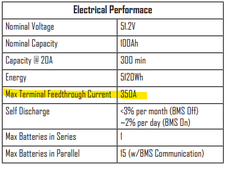Bluedog225
Texas
- Joined
- Nov 18, 2019
- Messages
- 2,917
Good morning,
I’m getting to the stage that I need to build out my solar array and had a really basic question.
Victron system with SOK 48 volt rack batteries.
I’ve got a variety of small-medium MPPT controllers and may get a couple of larger controllers.
I vaguely understand over-paneling and the potential for clipping. And I understand temperature compensated voltage limitations.
What I don’t quite get yet is the significance of putting too many amps on the bus bar that feeds the batteries.
That is, the SOK battery charging limit is 100 amps. What happens if there are three (or more) 50 amp MPPT controllers all putting full power onto the bus bar with a single battery?
Since there are 4 SOK batteries in parallel, does that increase the charge capacity to 400 amps?
But I still have the same question, what if more amps are available?
Do the batteries self limit their input?
What’s the electrical principal here?
Thanks
I’m getting to the stage that I need to build out my solar array and had a really basic question.
Victron system with SOK 48 volt rack batteries.
I’ve got a variety of small-medium MPPT controllers and may get a couple of larger controllers.
I vaguely understand over-paneling and the potential for clipping. And I understand temperature compensated voltage limitations.
What I don’t quite get yet is the significance of putting too many amps on the bus bar that feeds the batteries.
That is, the SOK battery charging limit is 100 amps. What happens if there are three (or more) 50 amp MPPT controllers all putting full power onto the bus bar with a single battery?
Since there are 4 SOK batteries in parallel, does that increase the charge capacity to 400 amps?
But I still have the same question, what if more amps are available?
Do the batteries self limit their input?
What’s the electrical principal here?
Thanks




